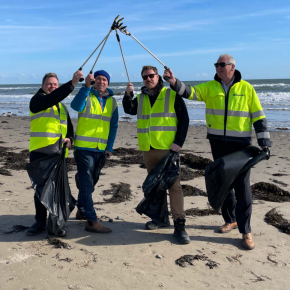
Health + Safety – Beyond Slips, Trips + Falls: an article by Your Legal Friend
The following article on health and safety in the workplace comes courtesy of personal injury specialists, Your Legal Friend.
“CONSTRUCTION health and safety has to account for a large number of variables, from working with pool tools to working at height, to the use of heavy machinery; it’s a constant battle for any site manager to ensure all employees are trained and following the set protocol.
Due to so many immediate health concerns, work-related illnesses that develop as the result of long-term exposure, or have long incubation periods, often see safety standards fall short first.
It’s not hard to see why; construction is second only to agriculture, forestry and fishing for rates of workplace injury. A breakdown of types of construction injury shows that accidents, such as falls from height or being struck by a vehicle, do account for the vast majority of reported incidents, but with 80,000 workers suffering from work-related ill health each year, illness caused over long periods is also major issue and one that isn’t getting the attention it needs.
Not addressing these health concerns is a problem for your business, opening yourselves up to thousands of lost work hours and even negligence claims.
When we talk of less immediate health and safety dangers, it doesn’t mean we’re looking at illness years down the line (but that is something we will cover), exposure to something for a few weeks or months can be just as damaging.
On the lesser end of the scale is occupational dermatitis; usually caused by repeated contact with corrosive materials because of a lack of protective equipment or appropriate training.
Due to its more subtle beginnings, contact dermatitis or urticaria (a.k.a. Hives) might be missed or hidden by an employee, but it can become a chronic condition or lead to serious infection if left unaddressed.
You are going to be aware of what hazardous materials workers will be handling on your site, so providing gloves, sleeves or eye protection is a relatively simple task with few excuses for failing. It could be that all employees onsite must have gloves with them or there is a station set up near where chemicals are handled where PPE is kept.
Training would be key in injury prevention here, with an additional option of a wash station for particularly dangerous substances. Similarly, occupational asthma can occur in short timescales of a few week or months and become a chronic condition, perhaps leading to a serious episode which could be life-threatening.
Much like dermatitis, asthma can be prevented by anticipating the types of work carried out, providing training and supplying the right PPE – in this case, dust masks. Depending on the environment, you may also
need ventilation or training on where to cut certain materials.
A warning sign of respiratory problems might be an increase in coughs and colds among your workers, so keep track of general respiratory health as well as more serious iterations. Looking at longer-term issues, noise-induced hearing loss and its companion tinnitus are what you should be most wary of.
Employees not using ear protection can be easy to miss, but again, is easy to remedy by making their use mandatory onsite unless specifically stated otherwise. Hearing loss or tinnitus can be caused quite quickly by a single incident that causes massive trauma or, more commonly, over a number of years of exposure.
This is one of the easiest issues to fix even if you’ve been lax for a while and is one of the more difficult conditions to prove for work injury compensation. However, that’s no excuse to let bad practices continue.
Finally, looking at long incubation periods, cancer is the horrible winner by far. In the EU, it’s estimated that 53% of all work-related deaths are from cancer caused by exposure to carcinogens in the workplace.
In the UK, there are an estimated 8,000 deaths each year, of these, nearly 4,000 are asbestos-related and, unfortunately, one type of asbestos-related cancer has a very low survival rate; around 50% of people with mesothelioma live longer than one year, and only 5-10% make it past five years.
It’s such a serious health problem the government has funding in place to help those diagnosed and unable to claim against former employers, but many chose to work with an asbestos solicitor to make a claim over government funding as often pays out much more.
As a workplace danger, asbestos is highly relevant to the construction industry, which has taken the lead in asbestos-related illness in recent years, and as such employers should be highly motivated to improve their health and safety standards related to it.
The best way to protect from asbestos is prevention; using surveys to detect its presence and then removing it using qualified professionals, if necessary. Training also goes a long way toward helping workers spot the material and have a process for dealing with it, such as immediately stopping work and reporting to the site manager.
There are some forms of asbestos that construction workers can remove without extensive training and PPE, this is known as NNLW (notifiable non-licenced work) and depends upon the condition of the asbestos material, duration of the work, the removal method and appropriate controls and training being in place.
These regulations are specific and extensive, so only take this path if you or your company are up to date with all of these; if not, keep workers safe rather than risking it.
Considering site safety beyond accidents and into health problems requires an extra level of forethought, but it is necessary to protect all workers from harm in an already hazardous work environment.
Latest news

11th April 2025
Don’t Do a Dave! It’s Time to Lock FIT Show 2025 in Your Calendar!
It’s that time again – FIT Show is back! You could be forgiven for thinking there won’t be much new to see when FIT Show returns to the NEC from 29 April – 1 May. Wrong!
Posted in Articles, Building Industry Events, Building Industry News, Building Products & Structures, Building Services, Continuing Professional Development (CPD's), Exhibitions and Conferences, Information Technology, Innovations & New Products, Restoration & Refurbishment, Retrofit & Renovation, Seminars, Training
11th April 2025
Insight Data: Boost construction success with project and prospect data
For those working in construction – in whatever capacity – the last few years haven’t been much fun. And according to the latest statistics, it would seem the challenges are continuing – Alex Tremlett, Insight Data’s Commercial Director, has more…
Posted in Articles, Building Industry News, Building Services, Information Technology, news, Research & Materials Testing
11th April 2025
ASSA ABLOY EMEIA: Learn how to tackle the security challenges of digitalising access with insights from industry experts
In a new series of videos, experts in various specialisms within ASSA ABLOY share their expertise on digital access, including the complexities to overcome and the range of benefits for those who get digital access right…
Posted in Access Control & Door Entry Systems, Architectural Ironmongery, Articles, Building Industry News, Building Products & Structures, Building Services, Doors, Facility Management & Building Services, Information Technology, Innovations & New Products, Posts, Restoration & Refurbishment, Retrofit & Renovation, Security and Fire Protection, Videos
10th April 2025
Geberit completes 150 Acts of Kindness
Geberit has raised nearly £14,000 for various charities through its ‘150 Acts of Kindness’ initiative, a year-long programme of fundraising and volunteering to mark the company’s 150th anniversary in 2024.
Posted in Articles, Bathrooms & Toilets, Bathrooms, Bedrooms & Washrooms, Building Industry Events, Building Industry News, Building Products & Structures, Building Services, Charity work, Drainage, Interiors, Pipes, Pipes & Fittings, Plumbing, Restoration & Refurbishment, Retrofit & Renovation
 Sign up:
Sign up: